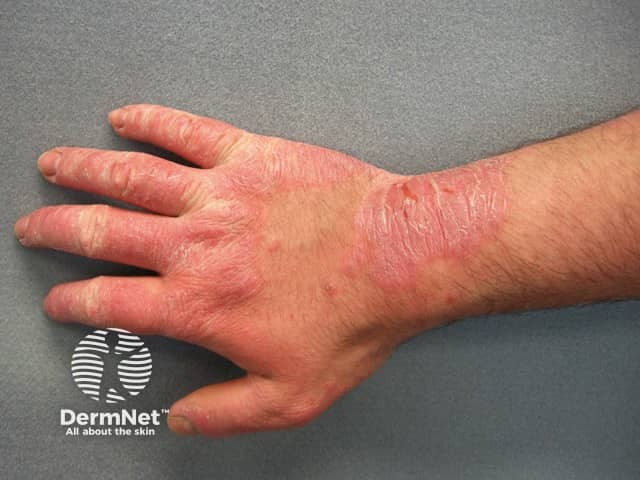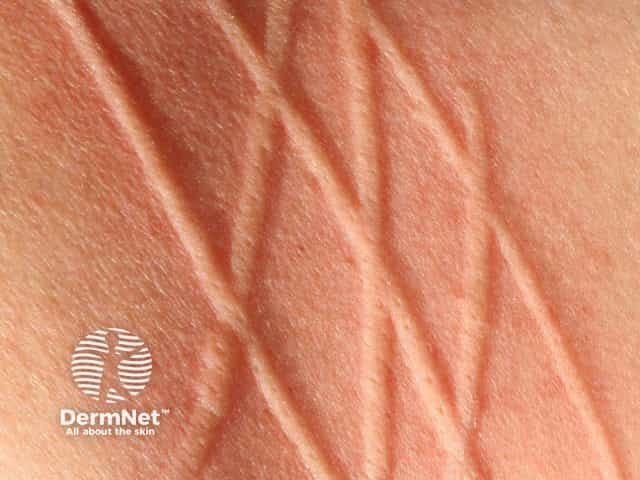Main menu
Common skin conditions

NEWS
Join DermNet PRO
Read more
Quick links
What is sensitive skin?
Clinical features
Causes of sensitive skin
Diagnosis
Proposed mechanisms
Treatment
Sensitive skin is a lay term rather than a medical diagnosis. It is generally used to describe skin with reduced tolerance to the application of cosmetics and personal care products. In surveys, approximately 50% of women and 40% of men may report having sensitive skin.
Sensitive skin presents in a wide variety of ways with:
Often, complaints of sensitive skin relate only to the face. Products that are tolerated on other sites cause irritation and rashes; eyelids are especially sensitive. Armpits, groin and genitals may also be more sensitive than other areas because of thinner skin.
There are a number of recognised medical causes of sensitive skin, including:
The term sensitive skin most often refers to a form of irritant contact dermatitis. This is defined as an inflammatory response of the skin to (an) externally applied agent(s) or factor(s) without requiring prior sensitisation, i.e., it is not due to allergy. Examples of such agents/factors include:
However host factors also influence susceptibility and these include age, sex, skin site and history of eczema.
Ten clinical types of ICD have been recognised, of which 8 present with clinically visible changes in the skin.

Hand dermatitis due to wet work

Rash caused by acne cleanser
Two forms of ICD show no clinical changes and these are therefore worth mentioning in more detail.
1. Subjective/sensory irritation, also known as sensorineural irritation
This is characterised by sensory discomfort such as itching, stinging, tingling or burning, but in the absence of any clinical or histological evidence of inflammation. Involvement of nerves and blood vessels contribute to the development of the symptoms. Lactic acid and propylene glycol in cosmetic agents are common causes of this. The threshold for developing symptoms following application of these chemicals to the skin varies between individuals and does not correlate with the person's susceptibility to other forms of skin irritation. It is generally of acute onset. Avoiding the irritant or using personal protective equipment such as gloves, and the frequent use of generous amounts of moisturiser usually results in a good outcome.
2. Non-erythematous irritation, also called suberythematous irritation
This form of irritant contact dermatitis differs from subjective irritation in that, although the person experiences similar symptoms and no rash is visible, there are changes of inflammation seen on skin biopsy. It often develops slowly and discomfort is experienced with multiple chemicals. Cocamidopropyl betaine and coconut diethanolamide are recognised causes of this and are common ingredients in cosmetics. The outcome with this form of ICD is variable.
Allergic contact dermatitis is a skin reaction following the development of an allergic response to an externally applied agent and is less common than irritant contact dermatitis. It typically develops increasing intensity with time. Some chemicals are known to commonly cause an allergic reaction but usually it is only in occasional or rare individuals that such a reaction develops. The causative agent can be identified by patch testing.

Dermatitis on hands

Patch tests positive to rubber glove

Reaction to thiuram, a component of rubber gloves
Contact urticaria is a form of hives triggered by skin contact with an agent that causes immediate swelling and redness and resolves over hours. It can be confirmed by prick testing. There are irritant and allergic forms of contact urticaria.

Prick testing

Reaction to venison

Reaction to latex
Rosacea is a common facial skin condition characterised by some or all of the following clinical features:
The skin sensitivity in this condition can present as skin redness or irritation after application to the face of the person's usual cosmetics and skin care products, often after years of uneventful use of the same product.

Mild

Moderate

Severe
Physical urticaria refers to hives triggered by a physical event such as pressure, heat, cold or vibration. Thus the person may erupt in a red rash while taking a hot shower for example. In this case, it is a reaction to the temperature of the water, and not to water itself, and the rash resolves within an hour after cooling.
Dermographism literally means to be able to write on the skin. The skin becomes red and puffy after a scratch.



Dermographism
In aquagenic pruritus, the skin becomes itchy following contact with water of any temperature.
Dry skin from any cause is irritable and sensitive. Skin may be dry due to:
Dry skin tends to be itchy, especially if overheated. The person is often using a number of products topically to try to improve this, and may therefore also develop a contact dermatitis.

Dryness due to ageing

Ichthyosis

Eczema due to dry skin
All forms of eczema or dermatitis (atopic, seborrhoeic, asteatotic, venous, etc.) can result in sensitive, easily irritated skin as the skin barrier has been disturbed, allowing external factors to penetrate. Eczema skin is usually itchy with a visible rash, which can further react to water, temperature, humidity and other environmental factors. Thus the presence of a second problem such as an irritant or allergic contact dermatitis to a product being applied to the skin may be overlooked. Eczema of any type is a well recognised predisposing factor for the development of irritant contact dermatitis.

Atopic eczema

Seborrhoeic eczema

Venous eczema
Skin sensitivity may take the form of a reaction to sunlight (photosensitivity) either as easy sunburn, hives, blisters or sensory symptoms such as tingling. There are many photodermatoses and these are described in more detail elsewhere on this website.

Photosensitivity

A phototoxic drug eruption due to an oral non-steroidal anti-inflammatory drug

Photosensitivity
Cutaneous mastocytosis is a rare group of conditions there are an excessive number of mast cells in the skin which can release histamine following stroking, pressure, heat, etc. This results in skin redness, puffiness and perhaps even blistering. The most common mastocystosis is called urticaria pigmentosa.

Urticaria pigmentosa in a child

Urticaria pigmentosa in an adult

Telangiectasia eruptiva macularis perstans
The cause of the sensitive skin may be diagnosed clinically and/or may require additional tests such as skin biopsy or patch testing.

Day 1

Day 5

Close-up of positive reaction
Skin irritation is a complex biologic event involving a variety of different receptor types.
Usually treatment is aimed at the underlying condition and avoidance, where possible, of the triggering agent/factor(s). Management may also include: